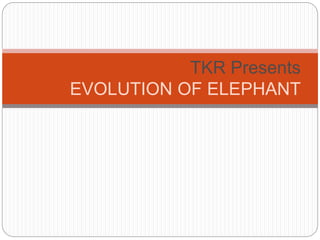
Evolution of elephant
- 1. TKR Presents EVOLUTION OF ELEPHANT
- 2. INTRODUCTION Elephants are giant terrestrial mammals. Characteristic feature of body is presence of trunk. Elephant shows social behavior or lives in society. Elephants distantly present communicate via infrasound. Elephants are commonly found in Africa and Asia. Male elephants are generally taller than females. Elephants have plantigrade posture. *Evolution is development process from simple form of life to complex.
- 3. POSITION OF ELEPHANT IN PHLOGENETIC TREE KINGDOM : Animalia PHYLUM : Chordata CLASS : Mammalia ORDER: Proboscidea
- 4. PROGENY LINES WITH TIME PERIOD TIME PERIOD MAIN LINES SIDE LINES EOCENE Moeritherium OLIGOCENE Palaeomastodon Phiomia True Mastodon MIOCENE Bunomastodon Miomastodon Deinotherium PLIOCENE Tetralophodon Steglophodon Stegodon Trilophodon Phiomastodon PLEISTOCENE Mastodon Stegomastodon RECENT Mammoth Loxodonta Elephas
- 6. EVOLUTIONARY TRENDS Increase in size and weight( elongation of limb bones and enlarged skull). Development and elongation of proboscis. Modification of second pair of incisors into tusks. Modification of dentition from bunodont (molar teeth with rounded cusps) to lophodont (grinding surface of molar teeth with transverse sutures).
- 8. MAIN LINES IN EVOLUTION 1.MOERITHERIUM * Swamp dweller. * About size of pig. * Bunodont dentition. * No proboscis. * Snot elongated. * Elongated body. * Short legs. *First lower incisor small whereas second lower incisor large suggesting development of tusks in later stages from it.
- 9. 2. PALAEOMASTODON * Arose from moeritherium. * During oligocene. * Proboscis short. * Upper tusks more elongated. *Lower tusks are short. * Gave rise to two lines Bunomastodon and Mastodon. 3. BUNOMASTODON * Arose from Palaeomastodon. * Tusks on both jaws. * Proboscis long. * Gave rise to several lines.
- 10. 4. TETRALOPHODON * Lived during pliocene. * Four cusps in four milk teeth and in first and second molar teeth. * Proboscis similar to modern elephants. * Four tusks present. * Molar high crowned. * Each molar with four crossing cusps. * Gave rise to two lines : Stegomastodon (side line) and Steglophodon (main line).
- 11. 5. STEGLOPHODON * Lived in pliocene. * Early records seen in Japan. * Early specimen showing bunodont indicating its origin from bunodont ancestors. * Only upper tusks present. * Lower tusks absent.
- 12. 6. STEGODON * Widely believed to be originated from steglophodon. Some believe this occurred in Africa and others believe it to have occurred in Asia. * Lived upto pleistocene. * Skull shortened. * Anterior part of mandible shortened. * Long proboscis. * Tusks are huge and generally lower tusks absent. * Teeth were high crowned. * Traditionally believed to be ancestor of Loxodonta, Elephas and Mammoths.
- 13. Mammoth, Elephas and Loxodonta, all three are under same subfamily Elephantinae. All three of them are hypsodont. 7. MAMMOTH * Like modern elephants but extinct. * Lived during pleistocene. * Strongly curved and twisted tusks. * Plate number and lamellar frequency in teeth increased with time. * Mammoth were generally adapted to cold environment.
- 14. 8. MODERN ELEPHANT * Represented by two genera, African elephant Loxodonta and Asian elephant Elephas. * Loxodonta have cheek teeth with high crowns. * Loxodonta is only taxa with thick rhomb shaped lophs. * Feeding pattern is browsing and grazing. * Early species of Elephas have low crown, low lamellar frequency and low enamel. * African elephants are characterized by great palmleaf-like ears, while Asian elephants ears are smaller.
- 15. SIDE LINES IN EVOLUTION OF ELEPHANT 1.PHIOMIA *Oligocene period. * Size double of Moeritherium. * Tusk present in both jaws. * Skull large with air cells. * Some evolutionists believed it to be in main line of evolution while others considered it in side line evolution.
- 16. 2. DEINOTHERIUM * Side line evolution. * Miocene period. * Lived in swamps. * Proboscis present * Dentition lophodont present as an adaptation to leaf eating. * First two premolars absent. * Since only two lobes present in second molar teeth whereas three lobes in second molar of palaeomastodon, its believed to have more primitive ancestor. * Only proboscidean in which upper pair of tusks absent. * Tusks curved downward and backward. * Size of deinotherians increased with time. * Cause of extinction is that they couldn’t change their eating habits with changing environment especially during winter season.
- 17. 3. MASTODON * Size of elephants. * Lived from upper oligocene to pleistocene. * Molar bilophodont. * Lower tusks absent. * Upper tusks curved as modern elephants. * Air spaces in skull.
- 18. 4. TRILOPHODONT * Present during pliocene. * Size of modern elephant. * Four tusks present. * Upper tusks elongated and lower tusks short. * First two molars have three pairs of transversely arranged cusps. * Molars low crowned.
- 19. SPECIAL FACTS ABOUT ELEPHANTS Trunk is formed from fusion of nose and upper lip. Air cavities are present in skull of elephant. Incisors form tusks. There are 6 sets of teeth throughout the life of elephant. Two types of tooth replacement, horizontal and vertical. In vertical replacement, milk teeth are replaced by premolars and premolars erupt later and remain in same place. In horizontal replacement, teeth move forward in mandible, worn out teeth drops out of mouth and new teeth arose at back of mandible.
- 20. THE END